| Formation of the Village of Clifton, Virginia |
| by Debbie Robison July 7, 2012 |
|
CliftonVirginia began as a small village situated at a railroad depot on the Orange, Alexandria and Manassas Railroad. Development of the village may be credited to Harrison G. Otis, a New York realtor, and William Harris and his family, who were freed African-American slaves. |
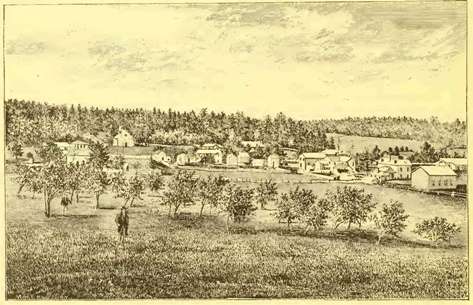
Sketch of Clifton, Virginia in View Looking to the Northeast. From the 1882 Excursion Guide of the Virginia Midland Railway. Courtesy Library of Congress and Internet Archive. |
|
Prior to emancipation, William Harris, his wife Harriet Harris, and their five children were slaves of William E. Beckwith. At his death in 1863, Beckwith owned 16 slaves, some of whom were his children.[1] The Harris’s, however, do not appear to be related to Beckwith, as they are listed in the 1870 census as black rather than mulatto.[2] In his will, Beckwith freed his slaves and bequeathed to them his land south of the railroad.[3] At the time that Beckwith wrote his will, all of his slaves were living north of the railroad.[4] When his estate was divided among the freed slaves, the Harris’s acquired a 77-acre tract of land that included the land where a Civil War-era railroad depot, known as Devereux Station, had been located.[5] William Harris constructed a house on this land ca. 1867.[6] Each member of the Harris family owned an undivided interest in the land. As the older children came of age, the family did not divide up the tract into equal shares but decided to take advantage of their location at the station to establish a village with small lots for sale. Since the land was owned in part by minors, Harris turned to the courts to legally sell the land. Thomas Moore, as a commissioner of the county court, oversaw the property sales and recordation of deeds for the village lots. The court commissioner, after ensuring the purchase price was paid in full, recorded the deeds. As the funds were received, the commissioner distributed the money to the Harris family members. Court documents archived at the Fairfax County Circuit Court contain purchase agreements, a plat of the lots, and accountings of the funds. The documents note that when Harris first approached the court to sell the land, there weren’t any buildings on the 77-acre tract.[7] Agreement was reached for the first sale of land on June 1, 1868. For $100, Harrison G. Otis purchased the northeast corner of the Harris property consisting of a 2-acre, triangular-shaped parcel on the east side of present-day Main Street. The deed was recorded the following year on March 6, 1869.[8] A train depot and steam-powered saw mill were constructed on this parcel.[9] The train station, known as Clifton Station, opened in November 1868 with E. B. Georgia appointed as the first station agent. It was anticipated at the time that a village would be established at the depot.[10] In November 1869, Otis applied to open a post office at Clifton Station.[11] Otis was already a nearby land owner. Previously, in December 1867, Otis entered into an agreement with the Beckwith estate to purchase almost 1,000 acres on the north side of the railroad.[12] This land was rich in timber, principally white oak, thus it made good business sense for Otis to have a saw mill conveniently located next to the railroad stop. Otis promoted land sales in the area, though he generally sold parcels north of the railroad measuring about 30 to 50 acres. William Harris must have constructed his home sometime prior to the sale of the land north of the railroad to Otis. |
|
William Harris House, Built ca. 1867 |
|
Otis resided in New York but sometimes stayed in the hotel he had constructed on the north side of the railroad that he called Clifton House. Construction of the hotel was in progress in November 1868.[13] It was open for business by the spring of 1869 when A. B. Nodine began operating the hotel/ summer boarding house.[14] |
|
Clifton House, Built ca. 1869 |
|
Otis sold a small lot in 1869 on the north side of the railroad across the street from the hotel to a trustee for Priscilla Hickey, wife Cyrus Hickey.[15] A building was constructed on the lot by 1871 when land taxes began being assessed on buildings valued at $400.[16] At that value, the building would have been rather substantial and may have been a store since Cyrus Hickey was a merchant. The top of this large building is depicted in an 1882 sketch of Clifton.[17] The building was evidently replaced with a small house, possibly after Priscilla Hickey’s death in 1908.[18] The Clifton Presbyterian Church was constructed of stone north of the railroad on a portion of land that had belonged to Otis. |
|
Clifton Presbyterian Church, Built ca. 1872 |
| Village Development |
|
William Harris had the portion his land located near the depot divided into ten lots. A plat was prepared by Hickey (probably Cyrus Hickey) depicting the lots, which were bounded by the railroad on the north, Main Street on the east, and South Street on the south (South Street was more commonly referred to as the “cross street to William Harris’s house”, but is now known as Chapel Street).[19] |
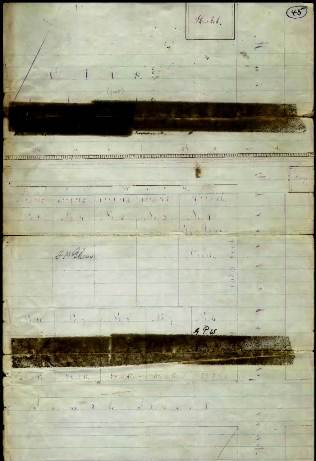
First Plat for the Village that Depicts the Earliest Lots. Courtesy Fairfax County Count Archives |
|
The plat shows that there were two rows of lots, back-to-back, containing five lots per row. A sidewalk is depicted between the lots and the railroad. Occasionally the names of the property owners were written on the plat. Lot 1, the first of the ten lots on the plat to be sold, was purchased by E. R. Ford and William E. Ford, trading as W E Ford & Co. The firm entered into an agreement with William Harris to purchase the lot in April 1869.[20] The agreement states that the lot was located at Clifton Station, so although the station would not open for another seven months, it was evidently planned. Ford constructed a store and dwelling on the lot ca. 1873, the year that the land tax records state that there were buildings added to the lot.[21] The original store and dwelling no longer exist. Currently there is a store and dwelling on the lot that were built in the mid-20th century. These buildings extend back into Lot 2. Lot 2 was originally purchased by E. B. Georgia, the first railroad station agent, in June 1869. There is no evidence that Georgia ever constructed any buildings on the lot. He did not pay the entire purchase amount for the lot before he transferred his interest in the lot to John Anderson. [22] The lot had several subsequent owners before being purchased in 1880 by William E. Ford.[23] His purchase of Lot 2 enlarged the lot area for his adjacent store and dwelling. |
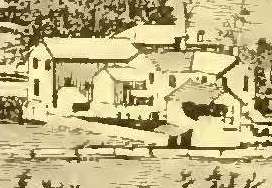
W E Ford & Co. Store and Residence, Built Ca. 1871. The roof just visible in the background may be Cyrus Hickey's Store. From the 1882 Excursion Guide of the Virginia Midland Railway. Courtesy Library of Congress and Internet Archive. |
|
Lot 3 was purchased by R. Benton Fitzhugh, a shoemaker. He originally entered into a contract to buy the lot in August 1869 for $60.[24] The following year he is listed in the census as a 28-year-old shoemaker of mixed race.[25] He was listed on the census, just before William Harris, with real estate valued at $100; therefore, it is possible he was living on the lot at this time. There was definitely a house on the lot by 1875 when the building was assessed at $200.[26] In 1880 the house and lot were valued at $300 with the household and kitchen furniture valued at $75. He also had two hogs valued at $5 and shoemaker’s tools, stock of shoes, and leather valued at $100.[27] Fitzhugh owned this lot until 1919. [28] This building no longer exists and the lot is vacant in 2012. Lot 4 was purchased by John D. Davis in November 1870 for $75. He assigned the lot over to J. L. Speaks and James P. Gheen. Speaks later assigned his interest over to Gheen, who received a deed for the land in 1876. [29] It was in 1876 that the land tax records first indicate that a building was located on this lot.[30] The house was of substantial size and doubled in value in 1881 from $200 to $400.[31] The house is shown on a sketch of Clifton in 1882.[32] It is reported that the house was relocated to an adjacent lot facing Chapel Street. The original land composing Lot 4 is vacant in 2012. |
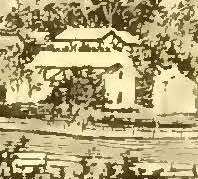
James Gheen House, Built ca. 1876. From the 1882 Excursion Guide of the Virginia Midland Railway. Courtesy Library of Congress and Internet Archive. |
|
House Reported to be the James Gheen House and Relocated in 1970, Built ca. 1876. |
|
Lot 5 was purchased by James L. Poston for $45. He entered into an agreement to purchase the lot in May 1869. By August 1870 the purchase price was paid and a deed was recorded placing the property in the name of Josephine E. Poston, wife of James L. Poston. The 1870 federal census indicates that James Poston was then a 28-year-old carpenter.[33] He likely constructed a house on the lot soon after he purchased the property. In 1870 his real estate was valued at $350.[34] The lot was sold to James W. Ashford in 1872 for $350.[35] Over the years the house decreased in value. By 1885, there were no buildings on the lot assessed a value.[36] It is unknown what happened to the house constructed by James Poston. It appeared in a sketch of Clifton in 1882 as a front-gable house, and is clearly not the same house that exists on that lot today.[37] |
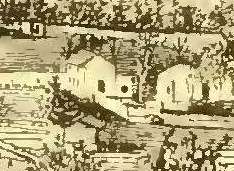
James Poston House (Just Left of Center), Built ca. 1870. From the 1882 Excursion Guide of the Virginia Midland Railway. Courtesy Library of Congress and Internet Archive. |
|
In 1885 Thomas W. Payne purchased the lot and placed it in trust for his wife, Martha Payne, and her children.[38] By 1890 a new house was constructed on the lot, possibly by Thomas Ayre who married Martha Payne’s daughter, Rosa L. Payne, about 1887.[39] Ayre, who was a store clerk and later a railroad agent, lived with his wife and mother-in-law for many years. [40] |
|
Ayre House, Built ca. 1890 |
|
George P. Wright entered into a contract in August 1869 to purchase Lot 6 and paid $10 towards the purchase price, but didn't finalize the sale.[41] Joseph H. Barnum purchased the lot in 1871 and entered into a trust agreement for $1,500 using Lot 6 as collateral.[42] The house was known as the Wright house in 1871.[43] Wright was still living there in 1875 when it is noted he occupied the house across from the lot sold to the Baptist Church.[44] An 1879 newspaper ad described the house as a dwelling house, built in modern style, 20 x 40 feet, with seven finished rooms besides the hall and kitchen.[45] William Bradley purchased the house in 1880.[46] The house is depicted in an 1882 railway excursion guide.[47] Joseph Speakes purchased the house in 1884 and sold it to Lewis Quigg in 1885.[48] |
|
Wright House, Built ca. 1871 |
|
In 1876, Lot 7 was purchased by William E. Ford who soon thereafter constructed a modest structure on this lot that was valued at $50 until 1891 when the value of buildings on the lot increased to $100.[49] The lot was sold to Lewis Quigg in 1913.[50] Quigg owned the adjacent Lot 6. In does not appear that Lot 8, Lot 9, or Lot 10 was ever sold as part of the early development of the village. |
| Eastern Village Expansion |
|
Businesswoman Margaret Hetzel became interested in the development of Clifton in September 1869 when she purchased a 1/3rd interest in H. G. Otis’s land and business holdings at Clifton Station.[51] By December she had agreed to purchase a 76-acre tract of land adjacent to Otis and William Harris. This land was part of the property that William Beckwith bequeathed to his slaves.[52] Hetzel and Otis had surveyor James P. Machen make a plat of their property near the railroad. The plat, which laid out the location of new streets, suggests that Otis and Hetzel were planning to follow in the footsteps of Harris and subdivide a portion of their land into lots.[53] |
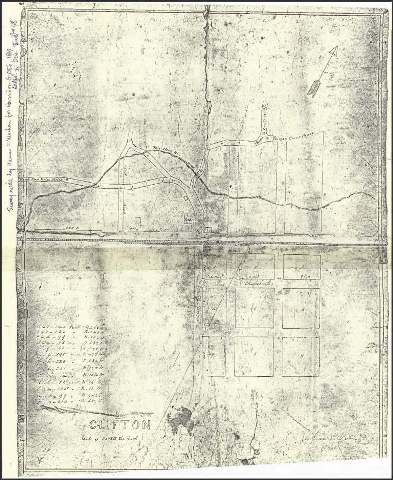
Second Plat of Clifton, by James P. Machen, December 1869. Courtesy Fairfax County Count Archives |
|
In order to align regional roads with the planned town streets, Hetzel petitioned the Fairfax County Court to change the location of the road through the village of Clifton. Prior to development of the village, the road crossed the railroad east of the present crossing. The following plat, which was prepared for the petition, shows the original road location.[54] |
|
Plat of Proposed Change of Road From Clifton to Wolf Run Shoals Road, 1870, Image Courtesy Fairfax County Circuit Court Archives |
|
In the early 1870s several lots along Main Street were sold by Otis; however, it was not long thereafter that Otis was deemed mentally incompetent and was no longer able to attend to his business.[55] A trustee, Sidney Dillon of NY, was appointed to act on his behalf. Until Otis’s death in 1885, future sales were made by his trustee. Margaret Hetzel sold several lots of her land; however, her business ventures in Clifton were not sufficiently successful for her to meet her financial obligations. [56] Overall, Hetzel and Otis’s development of Clifton did not achieve the success initially planned. |
| Harris’s Village Expansion |
|
Evidently, lots along Main Street or along the railroad were more desirable than lots on a cross street. Harris expanded his available lots for sale to include four lots on the southwestern side of Main Street just beyond the original lots. These lots were sold to the Baptist Church, William McEwan, George W. Marshall, and E. B. Georgia. He also sold a lot along the railroad adjacent to Lot 5. In 1875, trustees of the Baptist Church entered into an agreement with William Harris to purchase a lot 100 feet x 100 feet located on the corner of Main Street and the cross street to William Harris’s house (Chapel Street).[57] The founding trustees were Edward F. Simpson, Thomas T. Burke, and John W. Elgin. Their Baptist church was part of the New School persuasion. [58] The church building constructed on the lot was a rectangular-shaped wooden building with four windows on the southern side and likely a corresponding set of four windows on the northern side of the building. There were no windows on the rear of the church. The original church building is depicted on an 1882 sketch of Clifton.[59] |
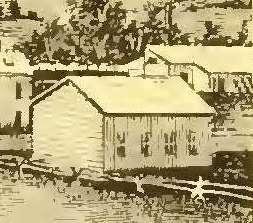
Clifton Baptist Church, Built Ca. 1876. From the 1882 Excursion Guide of the Virginia Midland Railway. Courtesy Library of Congress and Internet Archive. |
|
In 1910 the newspaper reported that a new church building was being built.[60] It was completed in 1912.[61] |
|
Clifton Baptist Church, Built Ca. 1911 |
|
William McEwan, of the City of New York, entered into a contract to purchase the lot on Main Street adjacent to the church lot in 1875 from William Harris.[62] The deed was recorded in 1882.[63] Beginning in 1883 the land tax records show that there was a small building on the lot; however, in 1885 there is no longer a building value assessed.[64] Andrew J. Kidwell purchased the lot in 1890.[65] By 1895 there was a small building on the lot valued at $50. The value increased to $175 by 1900.[66] It has been reported that this building was Andrew Kidwell’s blacksmith shop. George W. Marshall entered into an agreement in November 1875 to purchase the lot on Main Street adjacent to McEwan’s lot.[67] The deed was recorded in 1876.[68] Land tax records show a house value beginning in 1877.[69] Ownership of the house left the Marshall family in 1928 when it was purchased by George E. Kidwell.[70] |
|
George W. Marshall House, Built 1877 |
|
E. B. Georgia entered into a contract to purchase the lot on Main Street adjacent to Marshall’s lot. He was required to build upon the lot within 18 months.[71] He sold his interest in the lot to M. M. Payne in 1877.[72] The house was constructed in 1877 by M. M. Payne who was listed in the 1880 census as a 26-year-old house carpenter.[73] J. L. Speaks bought the house in 1884.[74] James W. Burdine bought the house in 1887.[75] Subsequently, Andrew J. Kidwell, a blacksmith, bought the house in 1894.[76] The house remained in the Kidwell family for many years. |
|
M. M. Payne's First Clifton House, Built 1877 |
|
William Harris also sold a lot high on a hill adjacent to the railroad and Lot 5 to Leander Makely. Although the deed was not recorded until 1879, Makely was assessed tax on buildings here in 1878.[77] He is shown living here on the 1878 Hopkins map. He was one of Clifton's merchants. Makely was deceased by 1886. The property descended to his daughter, Martha who married Charles H. Ford, son of William E. Ford, in 1907. The Fords sold the land to Frederick Sauber in 1922.[78] |
|
Leander Makely House, Built Ca. 1878 |
|
The remainder of the Harris land was subdivided among the children in 1891.[79] |
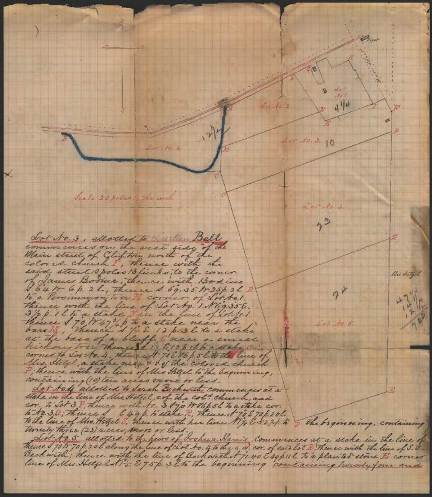
Division of Harris Land, November 1891. Image Courtesy Fairfax County Circuit Court. |
[1] Southern Claims Commission, Claim of Harrison G. Otis, Petition #21249, Report #9 Office 1618, 19th page, John Beckwith deposition, as viewed at www.ancestry.com.
[2] Federal Census of 1870, Viewed on Heritage Quest.
[3] Will of William E. Beckwith, Fairfax Will Book A2(676):98, probated on June 15, 1863.
[4] Will of William E. Beckwith, Fairfax Will Book A2(676):98, probated on June 15, 1863.
[5] Fairfax County Deed Book G4(85)566, December 18, 1866. Division of Beckwith’s estate.
[6] Fairfax County Deed Book H4(86)489, January 24, 1868. William Harris, one of William E. Beckwith's freed slaves, inherited this land in December 1866. Land tax records first show a house on this land in 1871, however, when Otis wanted a road constructed through Harris's property, Harris stated his concern that the road not be too close to his house. Harris must have moved prior to Otis's purchase of the land north of the railroad in January 1868.
[7] William Harris v. Joshua Harris, Fairfax County Chancery Case 1879-007, Fairfax County Circuit Court Archives, as viewed at http://www.lva.virginia.gov/chancery/ .
[8] Fairfax County Deed Book FX DB J4(88)272, March 6, 1869.
[9] Hetzel v. Otis, Fairfax County Chancery Case 1892-028, p. 149, 156.
[10] Alexandria Gazette, November 6, 1868, p. 3; Also, Alexandria Gazette, November 9, 1868, p. 3.
[11] Post Office Department Reports and Site Locations 1837-1950, National Archives and Record Service, Washington, DC, microfilm, Fairfax County Public Library, City of Fairfax Branch, Virginia Room.
[12] Fairfax County Deed Book H4(86)489, January 24, 1868.
[13] Alexandria Gazette, November 9, 1868, p. 3.
[14] Hetzel v. Otis, Fairfax County Chancery Case 1892-028, pp. 144, 155.
[15] Fairfax County Deed Book FX DB J4(88)400, March 8, 1869.
[16] Fairfax County Land Tax Ledger, 1871, microfilm, Fairfax County Public Library, City of Fairfax Branch, Virginia Room.
[17] The Virginia Midland Railway, Excursion Guide of the Virginia Midland Railway, The Short-Line Through-Car Route Between the North and South, 1882, p, 4, as viewed on Google Books.
[18] Fairfax Herald, January 31, 1908, p. 3.
[19] William Harris v. Joshua Harris, Fairfax County Chancery Case 1879-007, Fairfax County Circuit Court Archives, as viewed at http://www.lva.virginia.gov/chancery/ , p. 51.
[20] William Harris v. Joshua Harris, Fairfax County Chancery Case 1879-007, Fairfax County Circuit Court Archives, as viewed at http://www.lva.virginia.gov/chancery/ .
[21] Fairfax County Land Tax Ledger, 1873, microfilm, Fairfax County Public Library, City of Fairfax Branch, Virginia Room.
[22] William Harris v. Joshua Harris, Fairfax County Chancery Case 1879-007, Fairfax County Circuit Court Archives, as viewed at http://www.lva.virginia.gov/chancery/ .
[23] Fairfax County Deed Book Z4(104)349, November 5, 1880.
[24] William Harris v. Joshua Harris, Fairfax County Chancery Case 1879-007, Fairfax County Circuit Court Archives, as viewed at http://www.lva.virginia.gov/chancery/ .
[25] United States Federal Census, 1870.
[26] Fairfax County Land Tax Ledger, 1875, microfilm, Fairfax County Public Library, City of Fairfax Branch, Virginia Room.
[27] Fairfax County Deed Book Y4(103)328, February 19, 1880. R. Benton Fitzhugh claimed a Homestead Exemption for one house and lot in the village of Clifton.
[28] Fairfax County Deed Book N8(196)127, October 16, 1919.
[29] William Harris v. Joshua Harris, Fairfax County Chancery Case 1879-007, Fairfax County Circuit Court Archives, as viewed at http://www.lva.virginia.gov/chancery/ . Also Fairfax County Deed Book U4(99)197, June 26, 1876.
[30] Fairfax County Land Tax Ledger, 1876, microfilm, Fairfax County Public Library, City of Fairfax Branch, Virginia Room.
[31] Fairfax County Land Tax Records, 1876-1881, microfilm, Fairfax County Public Library, City of Fairfax Branch, Virginia Room.
[32] The Virginia Midland Railway, Excursion Guide of the Virginia Midland Railway, The Short-Line Through-Car Route Between the North and South, 1882, p, 4, as viewed on Google Books.
[33] United States Federal Census, 1870.
[34] United States Federal Census, 1870.
[35] Fairfax County Deed Book P4(94)43, November 13, 1872.
[36] Fairfax County Land Tax Ledgers, 1876 – 1885, microfilm, Fairfax County Public Library, City of Fair fax Branch, Virginia Room.
[37] The Virginia Midland Railway, Excursion Guide of the Virginia Midland Railway, The Short-Line Through-Car Route Between the North and South, 1882, p. 4, as viewed on Google Books.
[38] Fairfax County Deed Book E5(109)39, April 1, 1885.
[39] Fairfax County Land Tax Ledger, 1890, microfilm, Fairfax County Public Library, City of Fairfax Branch, Virginia Room.
[40] United States Federal Census, 1900.
[41] William Harris v. Joshua Harris, Fairfax County Chancery Case 1879-007, Fairfax County Circuit Court Archives, as viewed at http://www.lva.virginia.gov/chancery/ .
[42] Fairfax County Deed Book P4(94)344, July 1, 1871. Also, Fairfax County Deed Book N4(92)279, August 30, 1871.
[43] J Sanford Otis v. J J Barnum, Fairfax County Chancery 1871-032, December 2, 1871.
[44] William Harris v. Joshua Harris, Fairfax County Chancery Case 1879-007, July 16, 1875, p. 24, Fairfax County Circuit Court Archives, as viewed at http://www.lva.virginia.gov/chancery/ .
[45] Alexandria Gazette, December 11, 1879, p. 1.
[46] Fairfax County Deed Book Z4(104)167, January 10, 1880.
[47] The Virginia Midland Railway, Excursion Guide of the Virginia Midland Railway, The Short-Line Through-Car Route Between the North and South, 1882, p. 4, as viewed on Google Books.
[48] Fairfax County Deed Book D5(108)473, August 27, 1884; Also Fairfax County Deed Book E5(109)175, July 1, 1885.
[49] William Harris v. Joshua Harris, Fairfax County Chancery Case 1879-007, 1876, Fairfax County Circuit Court Archives, as viewed at http://www.lva.virginia.gov/chancery/ ; Also, Fairfax County Land Tax Ledgers, 1876-1900, microfilm, Fairfax County Public Library, City of Fairfax Branch, Virginia Room.
[50] Fairfax County Deed Book R7(174)410, November 13, 1913.
[51] Fairfax County Deed Book L4(90)46, September 10, 1869.
[52] Fairfax County Deed Book K4(89)465, January 1, 1870.
[53] Hetzel v. Otis, Fairfax County Chancery Case 1892-028, Fairfax County Circuit Court Archives, as viewed at http://www.lva.virginia.gov/chancery/
[54] Margaret Hetzel petition for Change of Road from Clifton to Wolf Run Shoals Road, Road Petitions 1870-1875, Fairfax County Circuit Court Archives.
[55] Fairfax County Deed Book L4(90)220, April 1, 1870; Fairfax County Deed Book O4(93)198, December 1, 1871; Fairfax County Deed Book O4(93)228, December 1, 1872; 1 Fairfax County Deed Book R4(96)261, April 1, 1873; Also, Hetzel vs. Otis, Fairfax County Chancer Case 1892-028, December 1, 1871, p. 146.
[56] Fairfax County Deed Book R4(96)260, May 17, 1874; Fairfax County Deed Book B5(106)329, July 17, 1882; Fairfax County Deed Book B5(106)397, August 8, 1882; Fairfax County Deed Book C5(107)396, September 19, 1882.
[57] William Harris v. Joshua Harris, Fairfax County Chancery Case 1879-007, Fairfax County Circuit Court Archives, as viewed at http://www.lva.virginia.gov/chancery/
[58] Fairfax County Deed Book Y4(103)264, July 4, 1877. Although the church trustees entered into an agreement to purchase the lot in 1875, the deed was not recorded until the full purchase price was paid.
[59] The Virginia Midland Railway, Excursion Guide of the Virginia Midland Railway, The Short-Line Through-Car Route Between the North and South, 1882, p. 4, as viewed on Google Books.
[60] Fairfax Herald, August 26, 1910, p. 2.
[61] Fairfax Herald, July 5, 1912, p. 2.
[62] William Harris v. Joshua Harris, Fairfax County Chancery Case 1879-007, Fairfax County Circuit Court Archives, as viewed at http://www.lva.virginia.gov/chancery/
[63] Fairfax County Deed Book B5(106)397, August 24, 1882.
[64] Fairfax County Land Tax Ledgers, 1882-1885, microfilm, Fairfax County Public Library, City of Fairfax Branch, Virginia Room.
[65] Fairfax County Deed Book J5(114)280, August 30, 1890.
[66] Fairfax County Land Tax Ledgers, 1895-1900, microfilm, Fairfax County Public Library, City of Fairfax Branch, Virginia Room.
[67] William Harris v. Joshua Harris, Fairfax County Chancery Case 1879-007, Fairfax County Circuit Court Archives, as viewed at http://www.lva.virginia.gov/chancery/
[68] Fairfax County Deed Book U4(99)59, June 26, 1876.
[69] Fairfax County Land Tax Ledger, 1877, microfilm, Fairfax County Public Library, City of Fairfax Branch, Virginia Room.
[70] Fairfax County Deed Book J10(244)219, October 27, 1928.
[71] William Harris v. Joshua Harris, Fairfax County Chancery Case 1879-007, Fairfax County Circuit Court Archives, as viewed at http://www.lva.virginia.gov/chancery/
[72] Fairfax County Deed Book (101)484, November 6, 1878.
[73] Fairfax County Land Tax Ledger, 1877, microfilm, Fairfax County Public Library, City of Fairfax Branch, Virginia Room; Also, United States Federal Census, 1880.
[74] Fairfax County Deed Book D5(108)413, August 20, 1884.
[75] Fairfax County Deed Book G5(111)187, September 1, 1887.
[76] Fairfax County Deed Book R5(122)495, September 17, 1894; Also, United States Federal Census, 1900.
[77] Fairfax County Land Tax Ledger, 1878, microfilm, Fairfax County Public Library, City of Fairfax Branch, Virginia Room.; Also, Fairfax County Dee Book X4(102)109, January 20, 1879.
[78] Fairfax County Deed Book X8(206)248, April 28, 1922.
[79] Harris v. Harris, Fairfax County Chancery Case 1892-020.

